Deakin University HSH762: Resource Allocation and Priority Setting
VerifiedAdded on 2022/12/29
|12
|3583
|51
Report
AI Summary
This report delves into the critical aspects of healthcare resource allocation and priority setting, focusing on the Australian context. It begins by advocating for the establishment of an independent agency to oversee priority setting, supported by reasoning and empirical evidence. The report then emphasizes the importance of community involvement in determining ethical values and principles to guide resource allocation. It outlines specific values, such as human dignity, needs and solidarity, cost-effectiveness, and transparency, that should underpin priority setting in Australia. Furthermore, the report addresses the practical implementation of priority setting, considering key issues, economic theories, and empirical evidence, and proposes a structured approach that includes context analysis, priority approaches, and the structure of the independent agency. The report also explores the use of incremental approaches, disease severity approaches, and the importance of stakeholder involvement to ensure effective and equitable healthcare resource distribution.
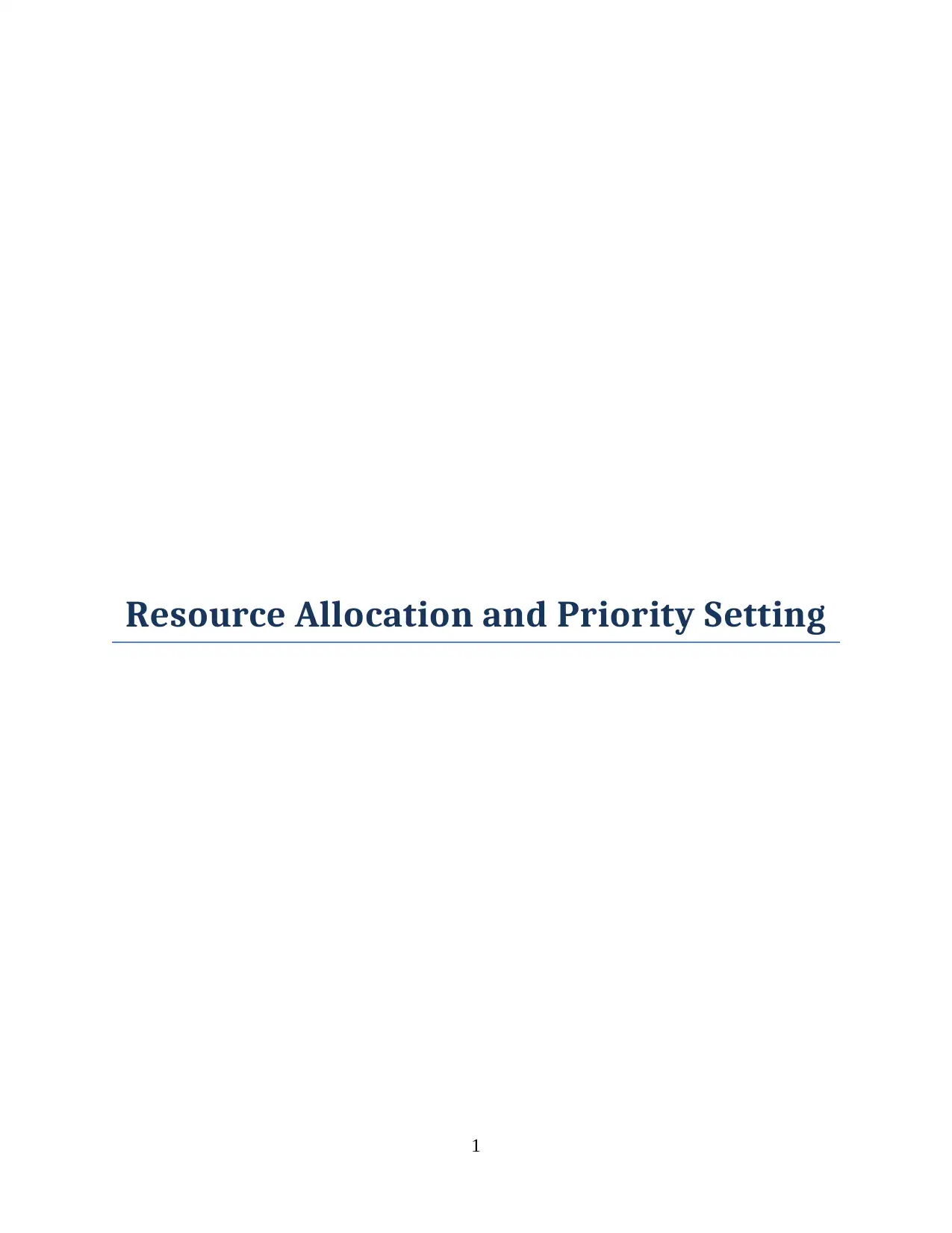
Resource Allocation and Priority Setting
1
1
Paraphrase This Document
Need a fresh take? Get an instant paraphrase of this document with our AI Paraphraser
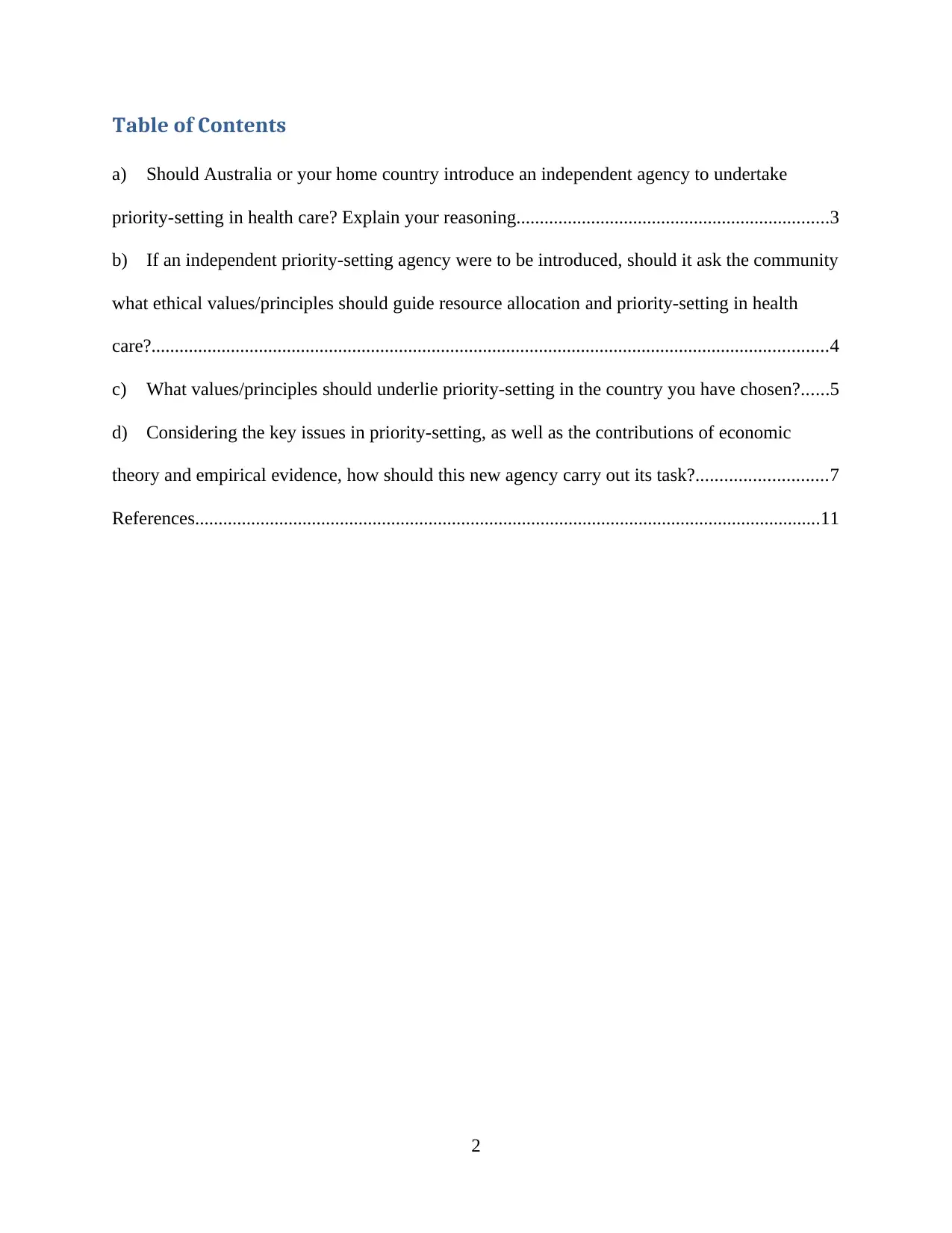
Table of Contents
a) Should Australia or your home country introduce an independent agency to undertake
priority-setting in health care? Explain your reasoning...................................................................3
b) If an independent priority-setting agency were to be introduced, should it ask the community
what ethical values/principles should guide resource allocation and priority-setting in health
care?.................................................................................................................................................4
c) What values/principles should underlie priority-setting in the country you have chosen?......5
d) Considering the key issues in priority-setting, as well as the contributions of economic
theory and empirical evidence, how should this new agency carry out its task?............................7
References......................................................................................................................................11
2
a) Should Australia or your home country introduce an independent agency to undertake
priority-setting in health care? Explain your reasoning...................................................................3
b) If an independent priority-setting agency were to be introduced, should it ask the community
what ethical values/principles should guide resource allocation and priority-setting in health
care?.................................................................................................................................................4
c) What values/principles should underlie priority-setting in the country you have chosen?......5
d) Considering the key issues in priority-setting, as well as the contributions of economic
theory and empirical evidence, how should this new agency carry out its task?............................7
References......................................................................................................................................11
2
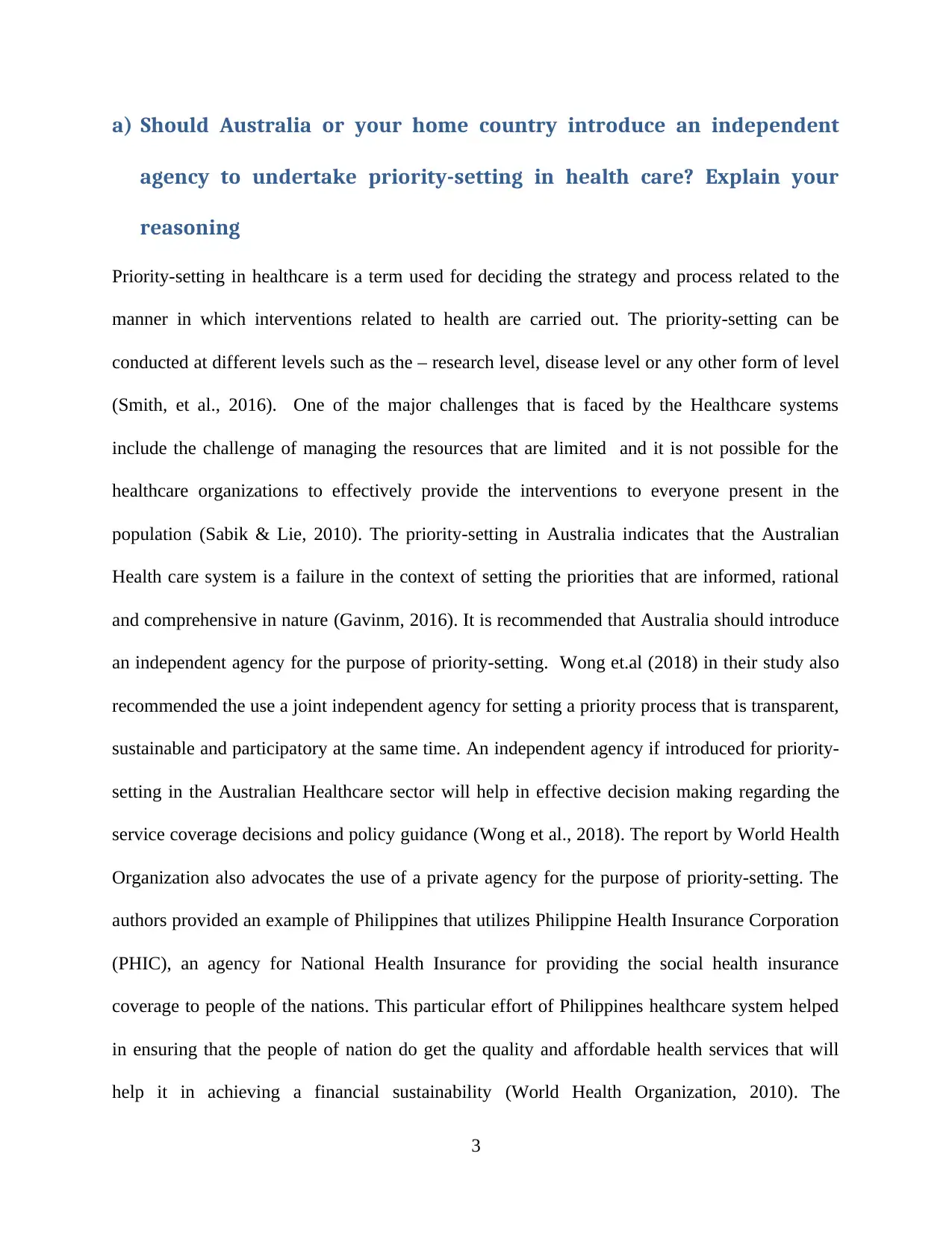
a) Should Australia or your home country introduce an independent
agency to undertake priority-setting in health care? Explain your
reasoning
Priority-setting in healthcare is a term used for deciding the strategy and process related to the
manner in which interventions related to health are carried out. The priority-setting can be
conducted at different levels such as the – research level, disease level or any other form of level
(Smith, et al., 2016). One of the major challenges that is faced by the Healthcare systems
include the challenge of managing the resources that are limited and it is not possible for the
healthcare organizations to effectively provide the interventions to everyone present in the
population (Sabik & Lie, 2010). The priority-setting in Australia indicates that the Australian
Health care system is a failure in the context of setting the priorities that are informed, rational
and comprehensive in nature (Gavinm, 2016). It is recommended that Australia should introduce
an independent agency for the purpose of priority-setting. Wong et.al (2018) in their study also
recommended the use a joint independent agency for setting a priority process that is transparent,
sustainable and participatory at the same time. An independent agency if introduced for priority-
setting in the Australian Healthcare sector will help in effective decision making regarding the
service coverage decisions and policy guidance (Wong et al., 2018). The report by World Health
Organization also advocates the use of a private agency for the purpose of priority-setting. The
authors provided an example of Philippines that utilizes Philippine Health Insurance Corporation
(PHIC), an agency for National Health Insurance for providing the social health insurance
coverage to people of the nations. This particular effort of Philippines healthcare system helped
in ensuring that the people of nation do get the quality and affordable health services that will
help it in achieving a financial sustainability (World Health Organization, 2010). The
3
agency to undertake priority-setting in health care? Explain your
reasoning
Priority-setting in healthcare is a term used for deciding the strategy and process related to the
manner in which interventions related to health are carried out. The priority-setting can be
conducted at different levels such as the – research level, disease level or any other form of level
(Smith, et al., 2016). One of the major challenges that is faced by the Healthcare systems
include the challenge of managing the resources that are limited and it is not possible for the
healthcare organizations to effectively provide the interventions to everyone present in the
population (Sabik & Lie, 2010). The priority-setting in Australia indicates that the Australian
Health care system is a failure in the context of setting the priorities that are informed, rational
and comprehensive in nature (Gavinm, 2016). It is recommended that Australia should introduce
an independent agency for the purpose of priority-setting. Wong et.al (2018) in their study also
recommended the use a joint independent agency for setting a priority process that is transparent,
sustainable and participatory at the same time. An independent agency if introduced for priority-
setting in the Australian Healthcare sector will help in effective decision making regarding the
service coverage decisions and policy guidance (Wong et al., 2018). The report by World Health
Organization also advocates the use of a private agency for the purpose of priority-setting. The
authors provided an example of Philippines that utilizes Philippine Health Insurance Corporation
(PHIC), an agency for National Health Insurance for providing the social health insurance
coverage to people of the nations. This particular effort of Philippines healthcare system helped
in ensuring that the people of nation do get the quality and affordable health services that will
help it in achieving a financial sustainability (World Health Organization, 2010). The
3
⊘ This is a preview!⊘
Do you want full access?
Subscribe today to unlock all pages.

Trusted by 1+ million students worldwide
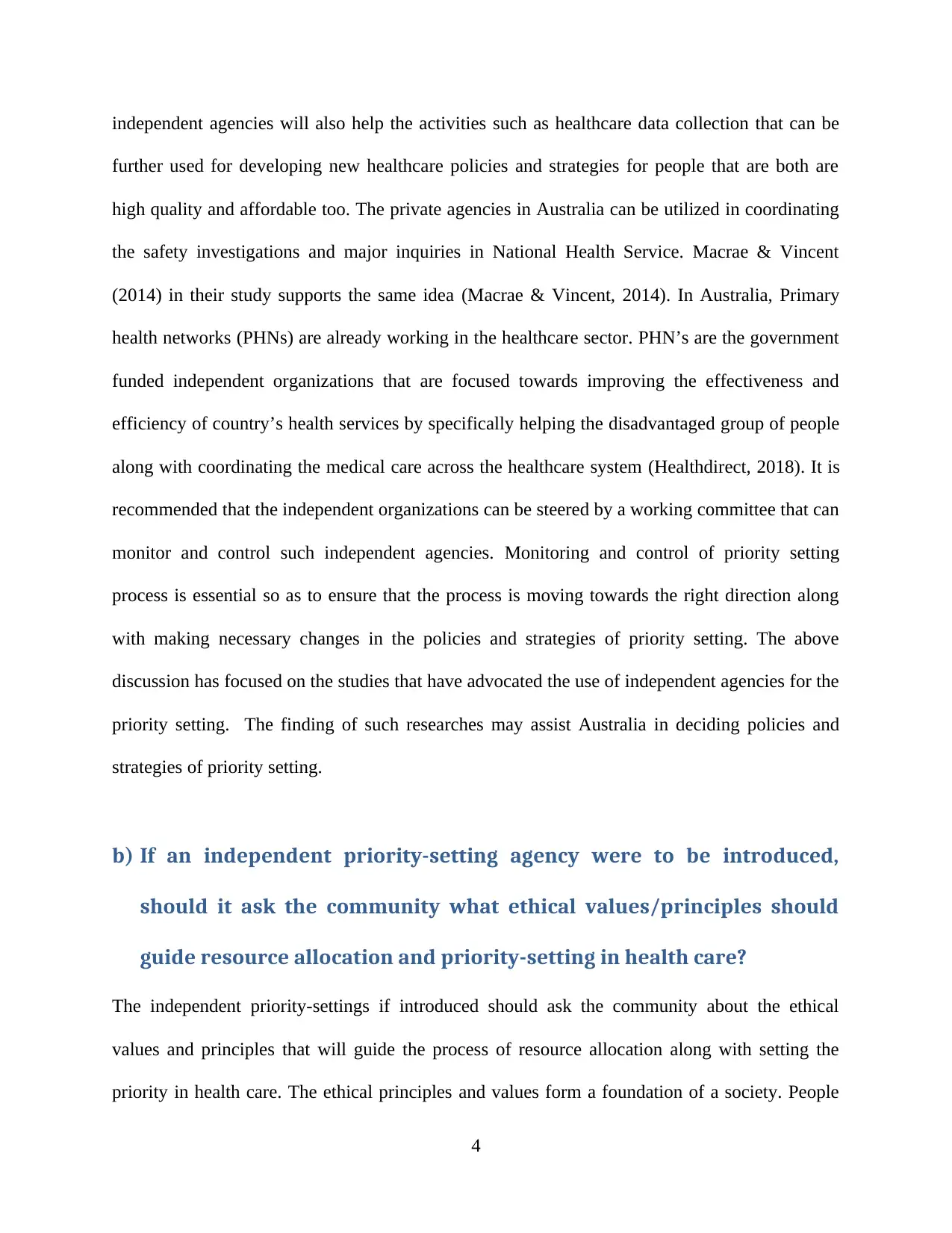
independent agencies will also help the activities such as healthcare data collection that can be
further used for developing new healthcare policies and strategies for people that are both are
high quality and affordable too. The private agencies in Australia can be utilized in coordinating
the safety investigations and major inquiries in National Health Service. Macrae & Vincent
(2014) in their study supports the same idea (Macrae & Vincent, 2014). In Australia, Primary
health networks (PHNs) are already working in the healthcare sector. PHN’s are the government
funded independent organizations that are focused towards improving the effectiveness and
efficiency of country’s health services by specifically helping the disadvantaged group of people
along with coordinating the medical care across the healthcare system (Healthdirect, 2018). It is
recommended that the independent organizations can be steered by a working committee that can
monitor and control such independent agencies. Monitoring and control of priority setting
process is essential so as to ensure that the process is moving towards the right direction along
with making necessary changes in the policies and strategies of priority setting. The above
discussion has focused on the studies that have advocated the use of independent agencies for the
priority setting. The finding of such researches may assist Australia in deciding policies and
strategies of priority setting.
b) If an independent priority-setting agency were to be introduced,
should it ask the community what ethical values/principles should
guide resource allocation and priority-setting in health care?
The independent priority-settings if introduced should ask the community about the ethical
values and principles that will guide the process of resource allocation along with setting the
priority in health care. The ethical principles and values form a foundation of a society. People
4
further used for developing new healthcare policies and strategies for people that are both are
high quality and affordable too. The private agencies in Australia can be utilized in coordinating
the safety investigations and major inquiries in National Health Service. Macrae & Vincent
(2014) in their study supports the same idea (Macrae & Vincent, 2014). In Australia, Primary
health networks (PHNs) are already working in the healthcare sector. PHN’s are the government
funded independent organizations that are focused towards improving the effectiveness and
efficiency of country’s health services by specifically helping the disadvantaged group of people
along with coordinating the medical care across the healthcare system (Healthdirect, 2018). It is
recommended that the independent organizations can be steered by a working committee that can
monitor and control such independent agencies. Monitoring and control of priority setting
process is essential so as to ensure that the process is moving towards the right direction along
with making necessary changes in the policies and strategies of priority setting. The above
discussion has focused on the studies that have advocated the use of independent agencies for the
priority setting. The finding of such researches may assist Australia in deciding policies and
strategies of priority setting.
b) If an independent priority-setting agency were to be introduced,
should it ask the community what ethical values/principles should
guide resource allocation and priority-setting in health care?
The independent priority-settings if introduced should ask the community about the ethical
values and principles that will guide the process of resource allocation along with setting the
priority in health care. The ethical principles and values form a foundation of a society. People
4
Paraphrase This Document
Need a fresh take? Get an instant paraphrase of this document with our AI Paraphraser
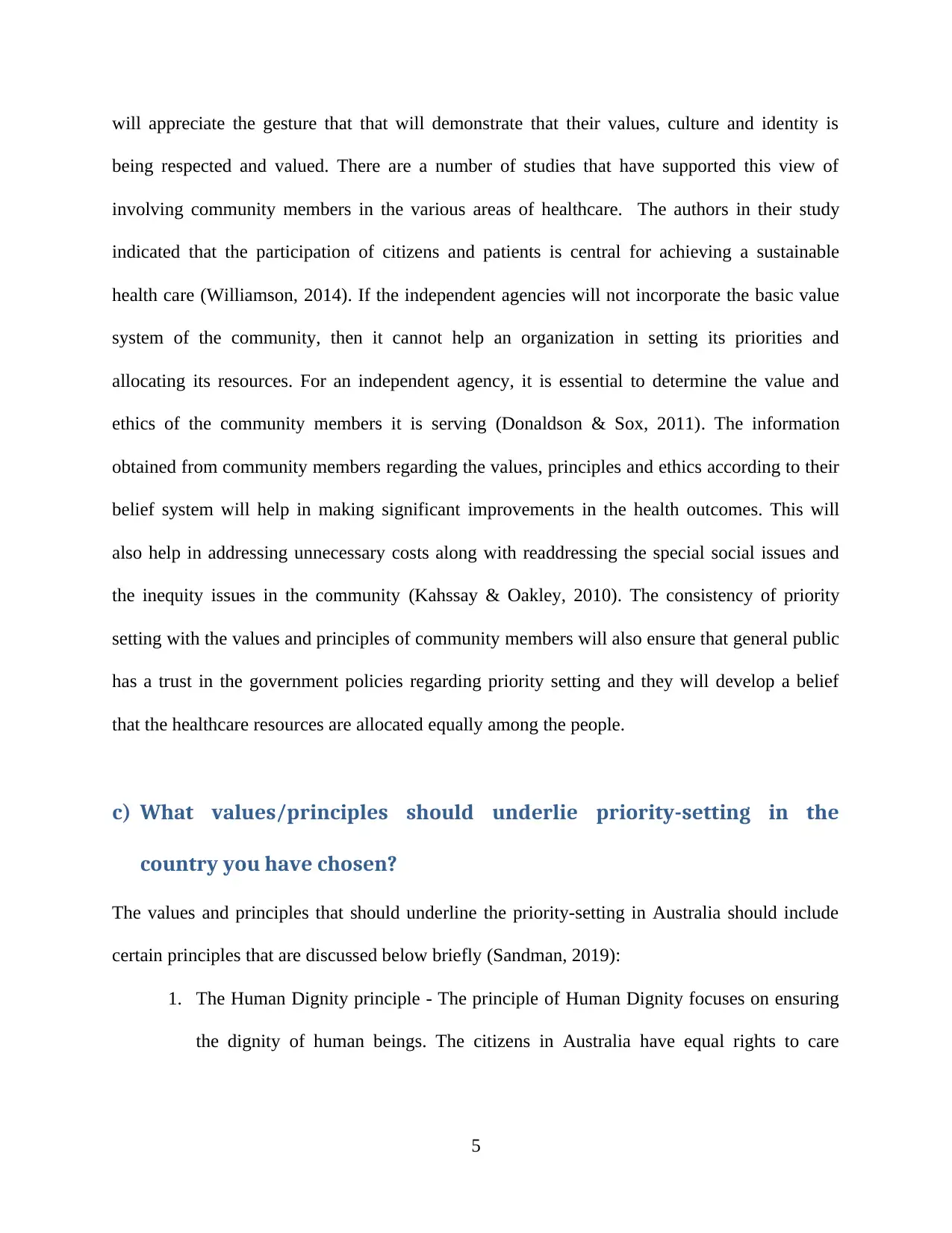
will appreciate the gesture that that will demonstrate that their values, culture and identity is
being respected and valued. There are a number of studies that have supported this view of
involving community members in the various areas of healthcare. The authors in their study
indicated that the participation of citizens and patients is central for achieving a sustainable
health care (Williamson, 2014). If the independent agencies will not incorporate the basic value
system of the community, then it cannot help an organization in setting its priorities and
allocating its resources. For an independent agency, it is essential to determine the value and
ethics of the community members it is serving (Donaldson & Sox, 2011). The information
obtained from community members regarding the values, principles and ethics according to their
belief system will help in making significant improvements in the health outcomes. This will
also help in addressing unnecessary costs along with readdressing the special social issues and
the inequity issues in the community (Kahssay & Oakley, 2010). The consistency of priority
setting with the values and principles of community members will also ensure that general public
has a trust in the government policies regarding priority setting and they will develop a belief
that the healthcare resources are allocated equally among the people.
c) What values/principles should underlie priority-setting in the
country you have chosen?
The values and principles that should underline the priority-setting in Australia should include
certain principles that are discussed below briefly (Sandman, 2019):
1. The Human Dignity principle - The principle of Human Dignity focuses on ensuring
the dignity of human beings. The citizens in Australia have equal rights to care
5
being respected and valued. There are a number of studies that have supported this view of
involving community members in the various areas of healthcare. The authors in their study
indicated that the participation of citizens and patients is central for achieving a sustainable
health care (Williamson, 2014). If the independent agencies will not incorporate the basic value
system of the community, then it cannot help an organization in setting its priorities and
allocating its resources. For an independent agency, it is essential to determine the value and
ethics of the community members it is serving (Donaldson & Sox, 2011). The information
obtained from community members regarding the values, principles and ethics according to their
belief system will help in making significant improvements in the health outcomes. This will
also help in addressing unnecessary costs along with readdressing the special social issues and
the inequity issues in the community (Kahssay & Oakley, 2010). The consistency of priority
setting with the values and principles of community members will also ensure that general public
has a trust in the government policies regarding priority setting and they will develop a belief
that the healthcare resources are allocated equally among the people.
c) What values/principles should underlie priority-setting in the
country you have chosen?
The values and principles that should underline the priority-setting in Australia should include
certain principles that are discussed below briefly (Sandman, 2019):
1. The Human Dignity principle - The principle of Human Dignity focuses on ensuring
the dignity of human beings. The citizens in Australia have equal rights to care
5
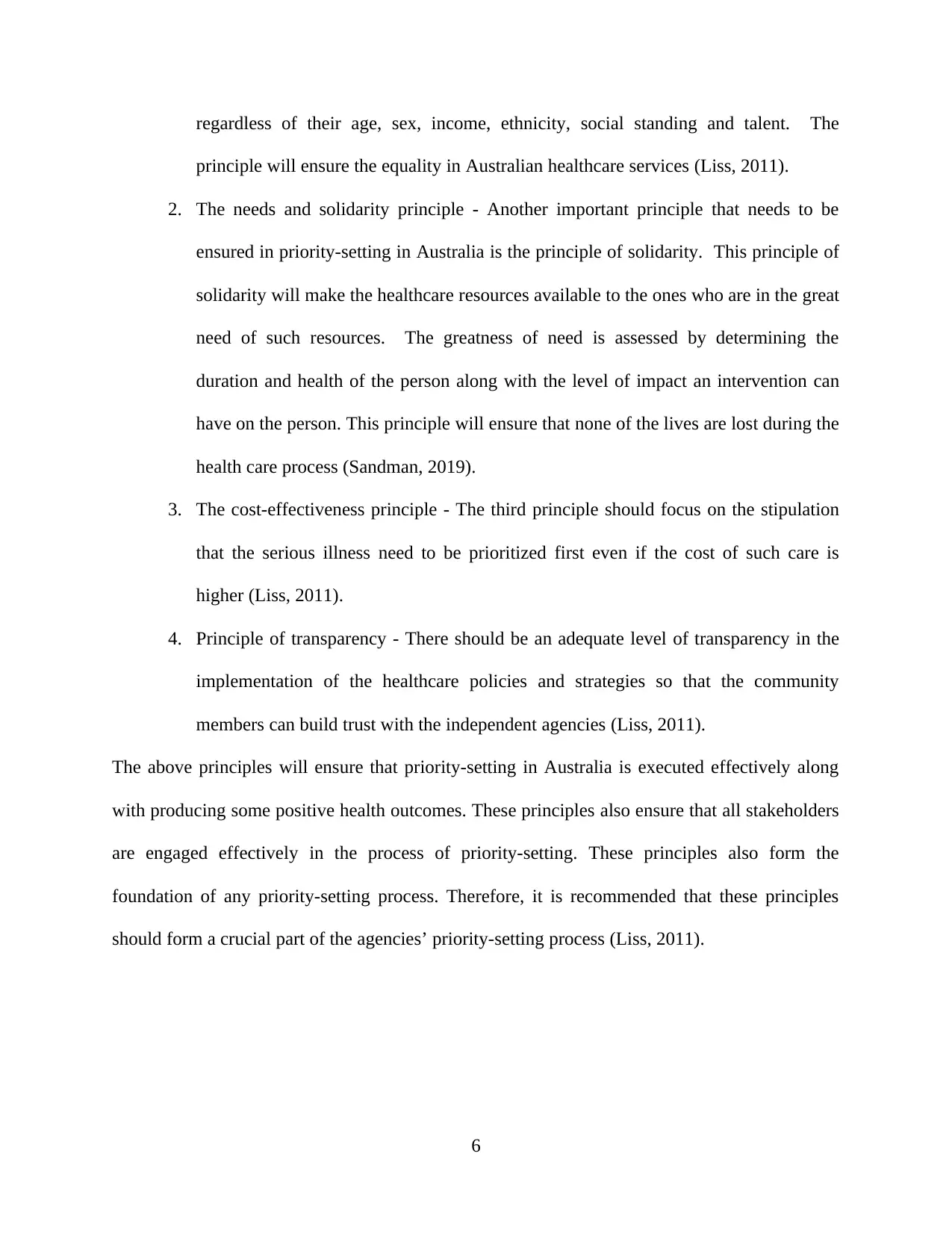
regardless of their age, sex, income, ethnicity, social standing and talent. The
principle will ensure the equality in Australian healthcare services (Liss, 2011).
2. The needs and solidarity principle - Another important principle that needs to be
ensured in priority-setting in Australia is the principle of solidarity. This principle of
solidarity will make the healthcare resources available to the ones who are in the great
need of such resources. The greatness of need is assessed by determining the
duration and health of the person along with the level of impact an intervention can
have on the person. This principle will ensure that none of the lives are lost during the
health care process (Sandman, 2019).
3. The cost-effectiveness principle - The third principle should focus on the stipulation
that the serious illness need to be prioritized first even if the cost of such care is
higher (Liss, 2011).
4. Principle of transparency - There should be an adequate level of transparency in the
implementation of the healthcare policies and strategies so that the community
members can build trust with the independent agencies (Liss, 2011).
The above principles will ensure that priority-setting in Australia is executed effectively along
with producing some positive health outcomes. These principles also ensure that all stakeholders
are engaged effectively in the process of priority-setting. These principles also form the
foundation of any priority-setting process. Therefore, it is recommended that these principles
should form a crucial part of the agencies’ priority-setting process (Liss, 2011).
6
principle will ensure the equality in Australian healthcare services (Liss, 2011).
2. The needs and solidarity principle - Another important principle that needs to be
ensured in priority-setting in Australia is the principle of solidarity. This principle of
solidarity will make the healthcare resources available to the ones who are in the great
need of such resources. The greatness of need is assessed by determining the
duration and health of the person along with the level of impact an intervention can
have on the person. This principle will ensure that none of the lives are lost during the
health care process (Sandman, 2019).
3. The cost-effectiveness principle - The third principle should focus on the stipulation
that the serious illness need to be prioritized first even if the cost of such care is
higher (Liss, 2011).
4. Principle of transparency - There should be an adequate level of transparency in the
implementation of the healthcare policies and strategies so that the community
members can build trust with the independent agencies (Liss, 2011).
The above principles will ensure that priority-setting in Australia is executed effectively along
with producing some positive health outcomes. These principles also ensure that all stakeholders
are engaged effectively in the process of priority-setting. These principles also form the
foundation of any priority-setting process. Therefore, it is recommended that these principles
should form a crucial part of the agencies’ priority-setting process (Liss, 2011).
6
⊘ This is a preview!⊘
Do you want full access?
Subscribe today to unlock all pages.

Trusted by 1+ million students worldwide
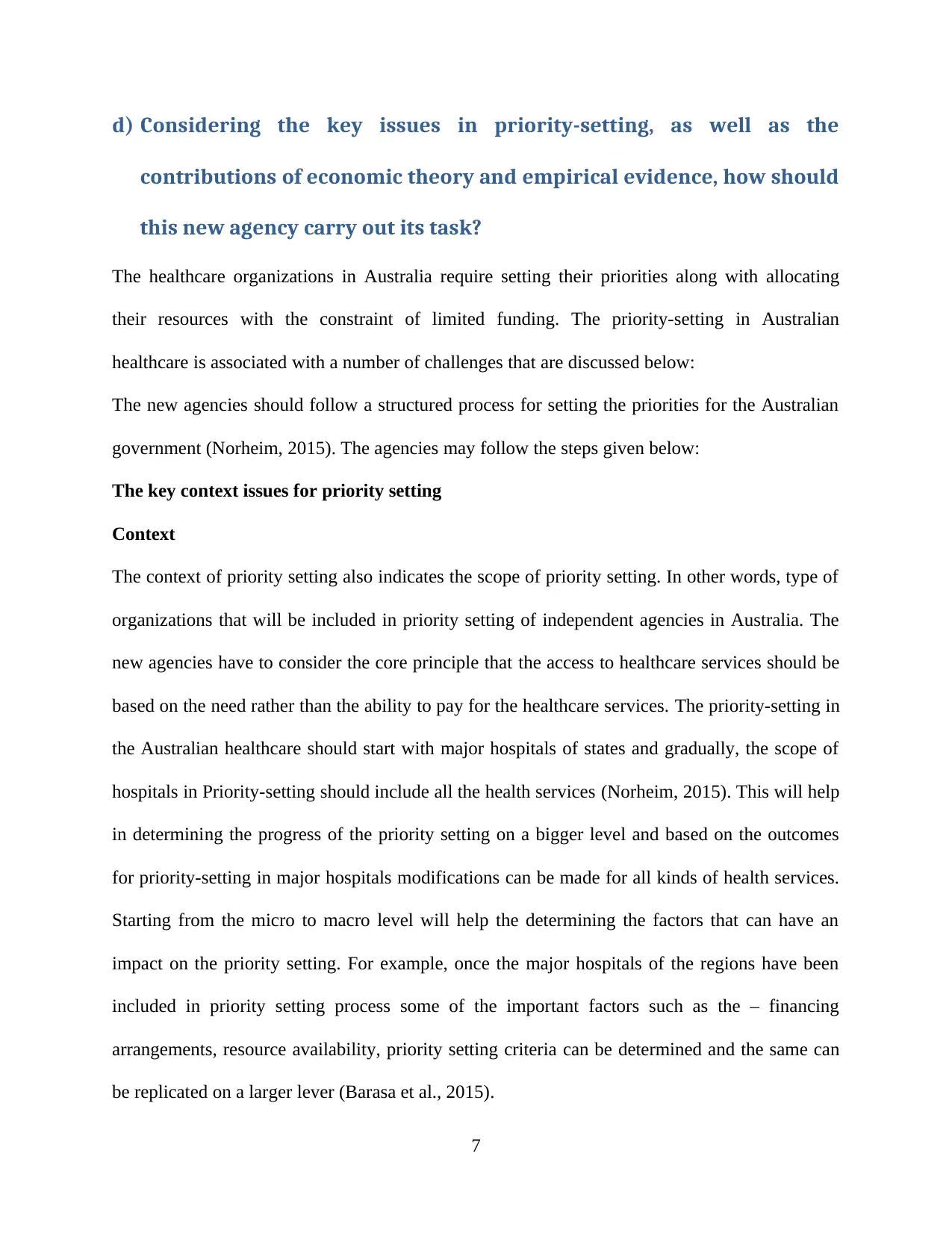
d) Considering the key issues in priority-setting, as well as the
contributions of economic theory and empirical evidence, how should
this new agency carry out its task?
The healthcare organizations in Australia require setting their priorities along with allocating
their resources with the constraint of limited funding. The priority-setting in Australian
healthcare is associated with a number of challenges that are discussed below:
The new agencies should follow a structured process for setting the priorities for the Australian
government (Norheim, 2015). The agencies may follow the steps given below:
The key context issues for priority setting
Context
The context of priority setting also indicates the scope of priority setting. In other words, type of
organizations that will be included in priority setting of independent agencies in Australia. The
new agencies have to consider the core principle that the access to healthcare services should be
based on the need rather than the ability to pay for the healthcare services. The priority-setting in
the Australian healthcare should start with major hospitals of states and gradually, the scope of
hospitals in Priority-setting should include all the health services (Norheim, 2015). This will help
in determining the progress of the priority setting on a bigger level and based on the outcomes
for priority-setting in major hospitals modifications can be made for all kinds of health services.
Starting from the micro to macro level will help the determining the factors that can have an
impact on the priority setting. For example, once the major hospitals of the regions have been
included in priority setting process some of the important factors such as the – financing
arrangements, resource availability, priority setting criteria can be determined and the same can
be replicated on a larger lever (Barasa et al., 2015).
7
contributions of economic theory and empirical evidence, how should
this new agency carry out its task?
The healthcare organizations in Australia require setting their priorities along with allocating
their resources with the constraint of limited funding. The priority-setting in Australian
healthcare is associated with a number of challenges that are discussed below:
The new agencies should follow a structured process for setting the priorities for the Australian
government (Norheim, 2015). The agencies may follow the steps given below:
The key context issues for priority setting
Context
The context of priority setting also indicates the scope of priority setting. In other words, type of
organizations that will be included in priority setting of independent agencies in Australia. The
new agencies have to consider the core principle that the access to healthcare services should be
based on the need rather than the ability to pay for the healthcare services. The priority-setting in
the Australian healthcare should start with major hospitals of states and gradually, the scope of
hospitals in Priority-setting should include all the health services (Norheim, 2015). This will help
in determining the progress of the priority setting on a bigger level and based on the outcomes
for priority-setting in major hospitals modifications can be made for all kinds of health services.
Starting from the micro to macro level will help the determining the factors that can have an
impact on the priority setting. For example, once the major hospitals of the regions have been
included in priority setting process some of the important factors such as the – financing
arrangements, resource availability, priority setting criteria can be determined and the same can
be replicated on a larger lever (Barasa et al., 2015).
7
Paraphrase This Document
Need a fresh take? Get an instant paraphrase of this document with our AI Paraphraser
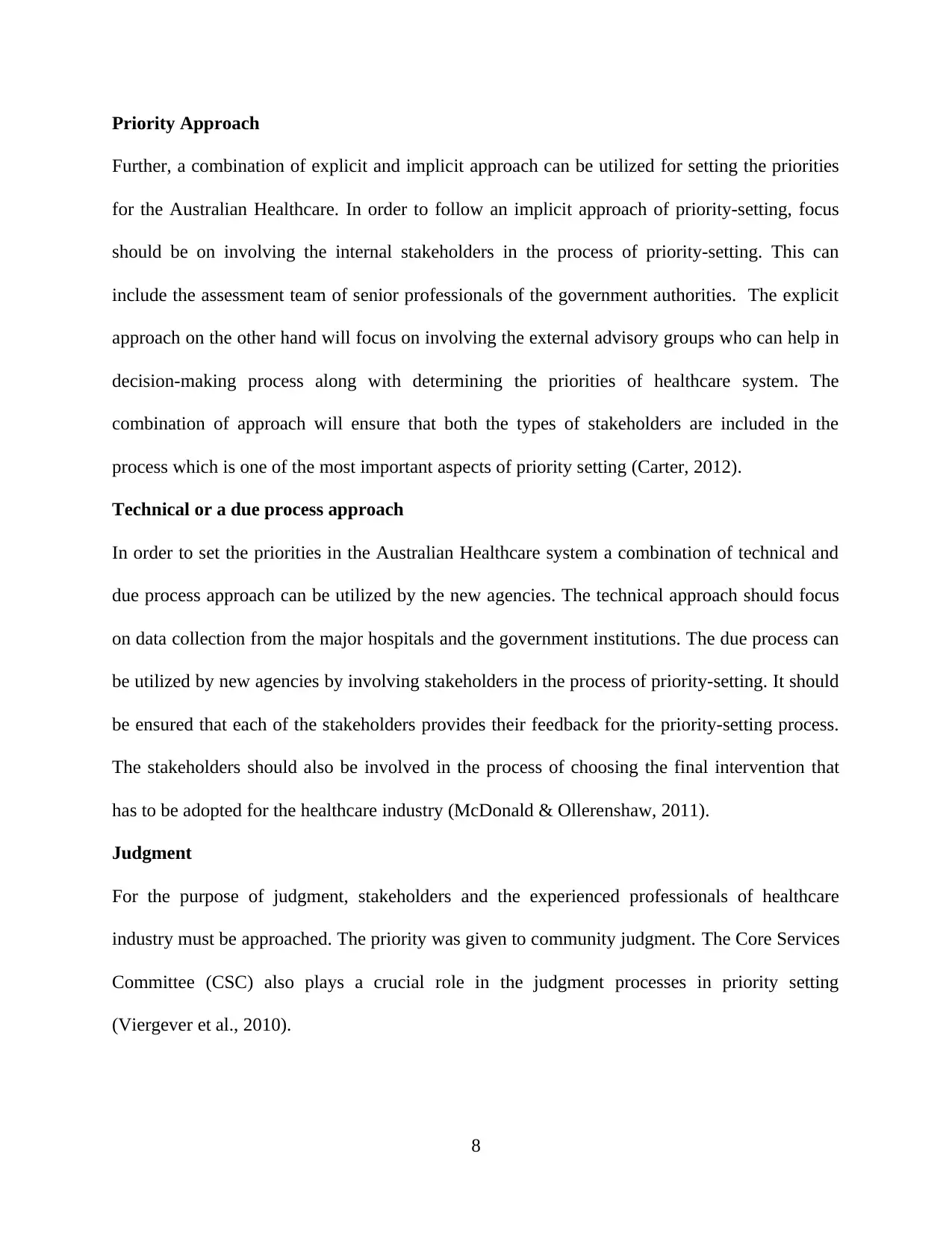
Priority Approach
Further, a combination of explicit and implicit approach can be utilized for setting the priorities
for the Australian Healthcare. In order to follow an implicit approach of priority-setting, focus
should be on involving the internal stakeholders in the process of priority-setting. This can
include the assessment team of senior professionals of the government authorities. The explicit
approach on the other hand will focus on involving the external advisory groups who can help in
decision-making process along with determining the priorities of healthcare system. The
combination of approach will ensure that both the types of stakeholders are included in the
process which is one of the most important aspects of priority setting (Carter, 2012).
Technical or a due process approach
In order to set the priorities in the Australian Healthcare system a combination of technical and
due process approach can be utilized by the new agencies. The technical approach should focus
on data collection from the major hospitals and the government institutions. The due process can
be utilized by new agencies by involving stakeholders in the process of priority-setting. It should
be ensured that each of the stakeholders provides their feedback for the priority-setting process.
The stakeholders should also be involved in the process of choosing the final intervention that
has to be adopted for the healthcare industry (McDonald & Ollerenshaw, 2011).
Judgment
For the purpose of judgment, stakeholders and the experienced professionals of healthcare
industry must be approached. The priority was given to community judgment. The Core Services
Committee (CSC) also plays a crucial role in the judgment processes in priority setting
(Viergever et al., 2010).
8
Further, a combination of explicit and implicit approach can be utilized for setting the priorities
for the Australian Healthcare. In order to follow an implicit approach of priority-setting, focus
should be on involving the internal stakeholders in the process of priority-setting. This can
include the assessment team of senior professionals of the government authorities. The explicit
approach on the other hand will focus on involving the external advisory groups who can help in
decision-making process along with determining the priorities of healthcare system. The
combination of approach will ensure that both the types of stakeholders are included in the
process which is one of the most important aspects of priority setting (Carter, 2012).
Technical or a due process approach
In order to set the priorities in the Australian Healthcare system a combination of technical and
due process approach can be utilized by the new agencies. The technical approach should focus
on data collection from the major hospitals and the government institutions. The due process can
be utilized by new agencies by involving stakeholders in the process of priority-setting. It should
be ensured that each of the stakeholders provides their feedback for the priority-setting process.
The stakeholders should also be involved in the process of choosing the final intervention that
has to be adopted for the healthcare industry (McDonald & Ollerenshaw, 2011).
Judgment
For the purpose of judgment, stakeholders and the experienced professionals of healthcare
industry must be approached. The priority was given to community judgment. The Core Services
Committee (CSC) also plays a crucial role in the judgment processes in priority setting
(Viergever et al., 2010).
8
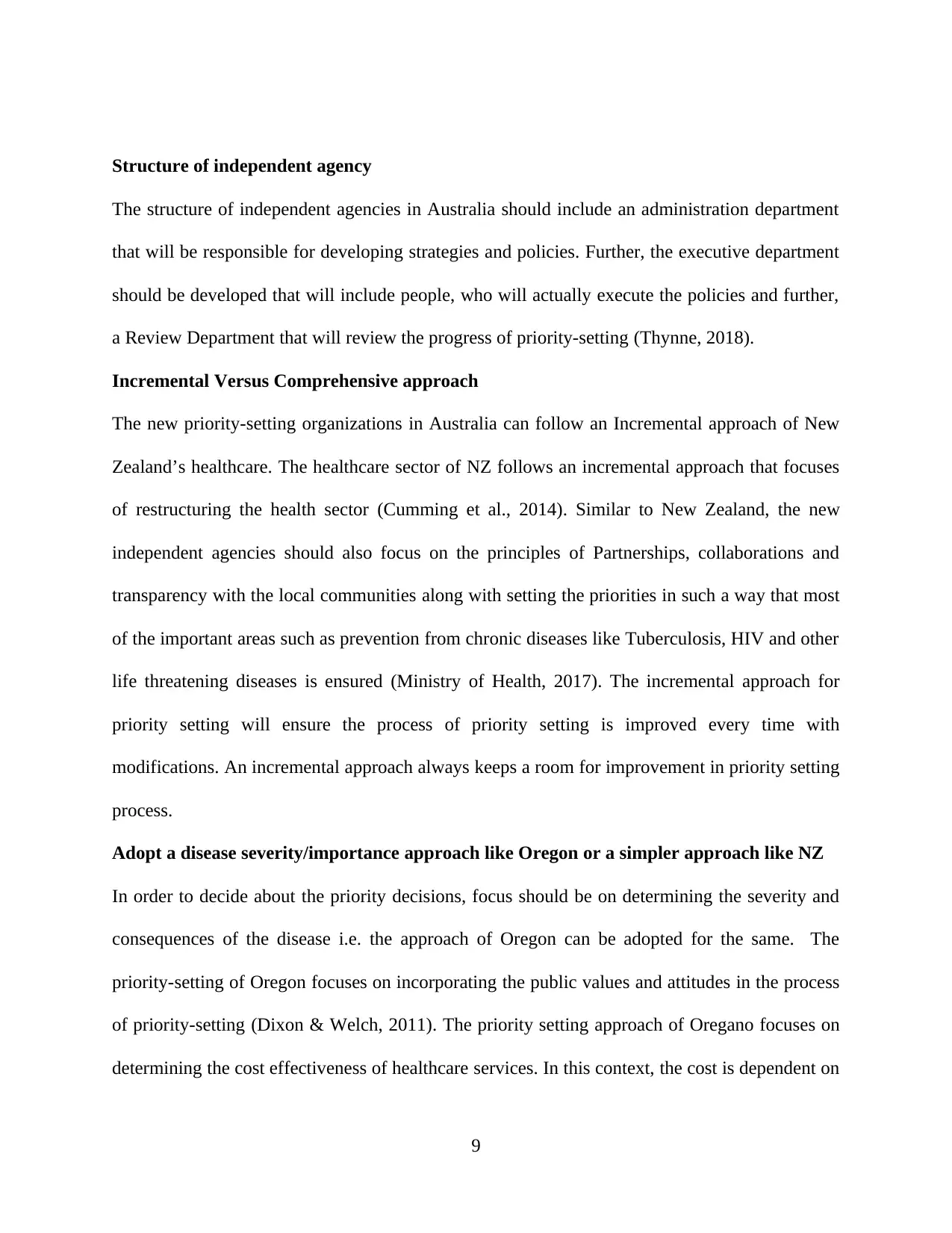
Structure of independent agency
The structure of independent agencies in Australia should include an administration department
that will be responsible for developing strategies and policies. Further, the executive department
should be developed that will include people, who will actually execute the policies and further,
a Review Department that will review the progress of priority-setting (Thynne, 2018).
Incremental Versus Comprehensive approach
The new priority-setting organizations in Australia can follow an Incremental approach of New
Zealand’s healthcare. The healthcare sector of NZ follows an incremental approach that focuses
of restructuring the health sector (Cumming et al., 2014). Similar to New Zealand, the new
independent agencies should also focus on the principles of Partnerships, collaborations and
transparency with the local communities along with setting the priorities in such a way that most
of the important areas such as prevention from chronic diseases like Tuberculosis, HIV and other
life threatening diseases is ensured (Ministry of Health, 2017). The incremental approach for
priority setting will ensure the process of priority setting is improved every time with
modifications. An incremental approach always keeps a room for improvement in priority setting
process.
Adopt a disease severity/importance approach like Oregon or a simpler approach like NZ
In order to decide about the priority decisions, focus should be on determining the severity and
consequences of the disease i.e. the approach of Oregon can be adopted for the same. The
priority-setting of Oregon focuses on incorporating the public values and attitudes in the process
of priority-setting (Dixon & Welch, 2011). The priority setting approach of Oregano focuses on
determining the cost effectiveness of healthcare services. In this context, the cost is dependent on
9
The structure of independent agencies in Australia should include an administration department
that will be responsible for developing strategies and policies. Further, the executive department
should be developed that will include people, who will actually execute the policies and further,
a Review Department that will review the progress of priority-setting (Thynne, 2018).
Incremental Versus Comprehensive approach
The new priority-setting organizations in Australia can follow an Incremental approach of New
Zealand’s healthcare. The healthcare sector of NZ follows an incremental approach that focuses
of restructuring the health sector (Cumming et al., 2014). Similar to New Zealand, the new
independent agencies should also focus on the principles of Partnerships, collaborations and
transparency with the local communities along with setting the priorities in such a way that most
of the important areas such as prevention from chronic diseases like Tuberculosis, HIV and other
life threatening diseases is ensured (Ministry of Health, 2017). The incremental approach for
priority setting will ensure the process of priority setting is improved every time with
modifications. An incremental approach always keeps a room for improvement in priority setting
process.
Adopt a disease severity/importance approach like Oregon or a simpler approach like NZ
In order to decide about the priority decisions, focus should be on determining the severity and
consequences of the disease i.e. the approach of Oregon can be adopted for the same. The
priority-setting of Oregon focuses on incorporating the public values and attitudes in the process
of priority-setting (Dixon & Welch, 2011). The priority setting approach of Oregano focuses on
determining the cost effectiveness of healthcare services. In this context, the cost is dependent on
9
⊘ This is a preview!⊘
Do you want full access?
Subscribe today to unlock all pages.

Trusted by 1+ million students worldwide
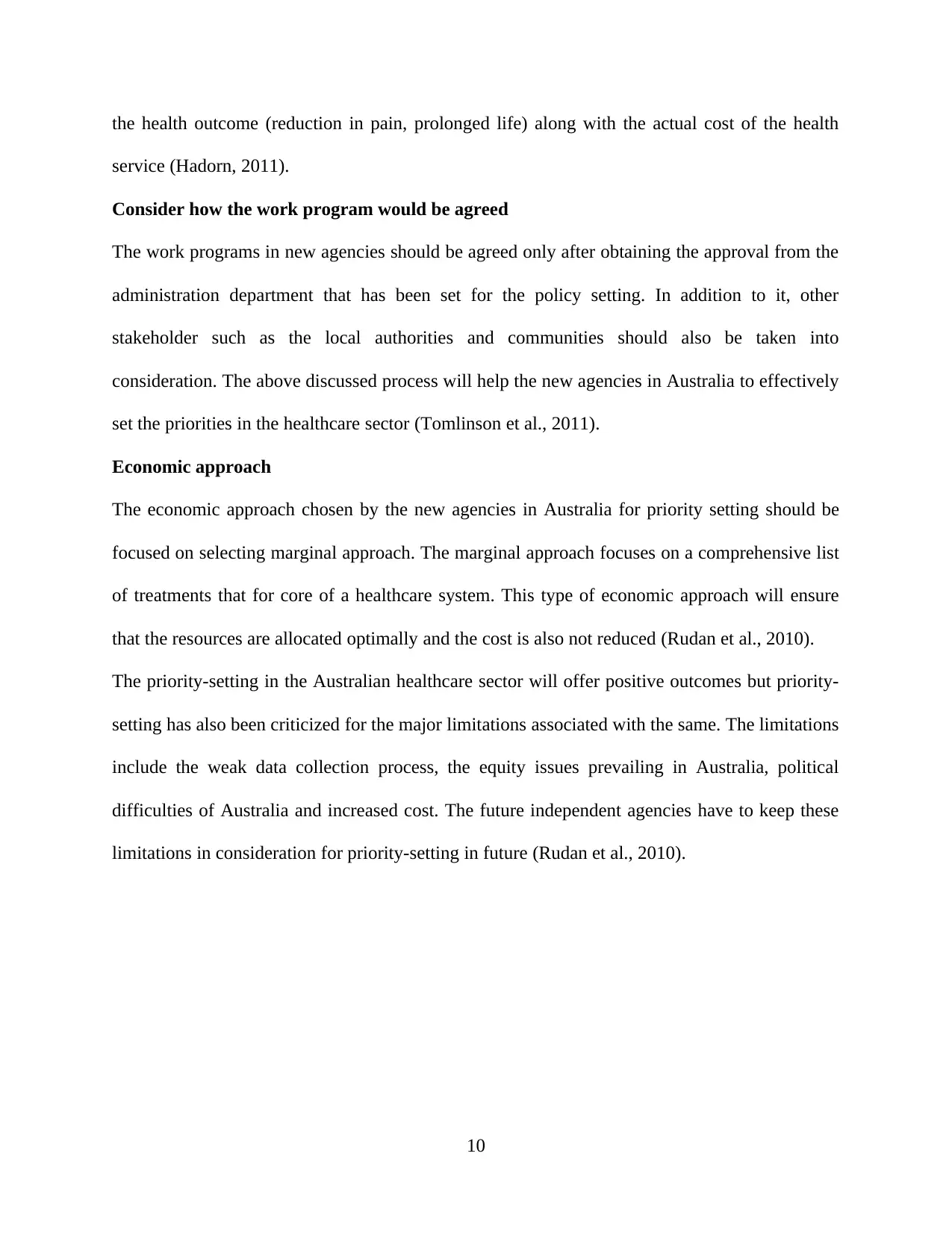
the health outcome (reduction in pain, prolonged life) along with the actual cost of the health
service (Hadorn, 2011).
Consider how the work program would be agreed
The work programs in new agencies should be agreed only after obtaining the approval from the
administration department that has been set for the policy setting. In addition to it, other
stakeholder such as the local authorities and communities should also be taken into
consideration. The above discussed process will help the new agencies in Australia to effectively
set the priorities in the healthcare sector (Tomlinson et al., 2011).
Economic approach
The economic approach chosen by the new agencies in Australia for priority setting should be
focused on selecting marginal approach. The marginal approach focuses on a comprehensive list
of treatments that for core of a healthcare system. This type of economic approach will ensure
that the resources are allocated optimally and the cost is also not reduced (Rudan et al., 2010).
The priority-setting in the Australian healthcare sector will offer positive outcomes but priority-
setting has also been criticized for the major limitations associated with the same. The limitations
include the weak data collection process, the equity issues prevailing in Australia, political
difficulties of Australia and increased cost. The future independent agencies have to keep these
limitations in consideration for priority-setting in future (Rudan et al., 2010).
10
service (Hadorn, 2011).
Consider how the work program would be agreed
The work programs in new agencies should be agreed only after obtaining the approval from the
administration department that has been set for the policy setting. In addition to it, other
stakeholder such as the local authorities and communities should also be taken into
consideration. The above discussed process will help the new agencies in Australia to effectively
set the priorities in the healthcare sector (Tomlinson et al., 2011).
Economic approach
The economic approach chosen by the new agencies in Australia for priority setting should be
focused on selecting marginal approach. The marginal approach focuses on a comprehensive list
of treatments that for core of a healthcare system. This type of economic approach will ensure
that the resources are allocated optimally and the cost is also not reduced (Rudan et al., 2010).
The priority-setting in the Australian healthcare sector will offer positive outcomes but priority-
setting has also been criticized for the major limitations associated with the same. The limitations
include the weak data collection process, the equity issues prevailing in Australia, political
difficulties of Australia and increased cost. The future independent agencies have to keep these
limitations in consideration for priority-setting in future (Rudan et al., 2010).
10
Paraphrase This Document
Need a fresh take? Get an instant paraphrase of this document with our AI Paraphraser
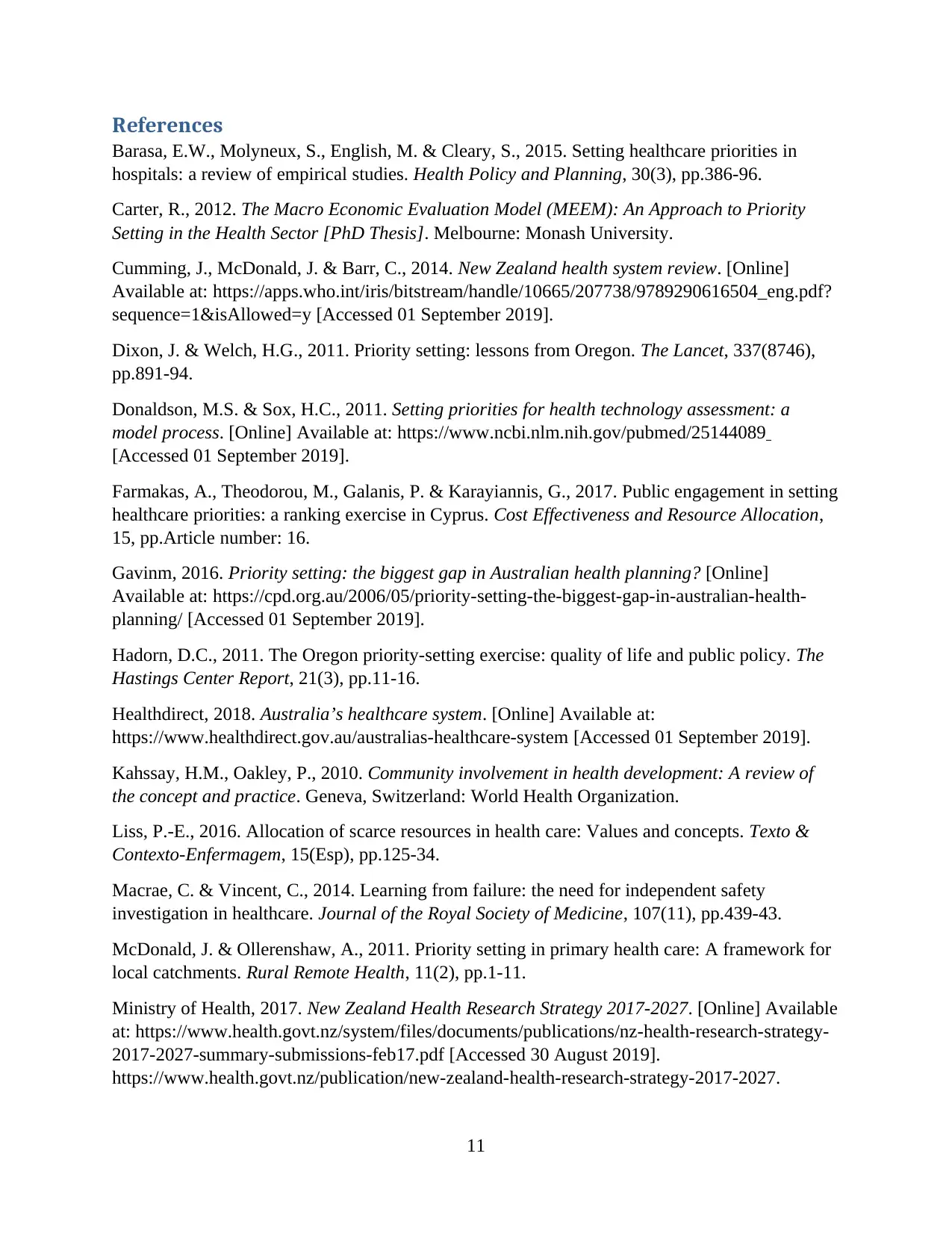
References
Barasa, E.W., Molyneux, S., English, M. & Cleary, S., 2015. Setting healthcare priorities in
hospitals: a review of empirical studies. Health Policy and Planning, 30(3), pp.386-96.
Carter, R., 2012. The Macro Economic Evaluation Model (MEEM): An Approach to Priority
Setting in the Health Sector [PhD Thesis]. Melbourne: Monash University.
Cumming, J., McDonald, J. & Barr, C., 2014. New Zealand health system review. [Online]
Available at: https://apps.who.int/iris/bitstream/handle/10665/207738/9789290616504_eng.pdf?
sequence=1&isAllowed=y [Accessed 01 September 2019].
Dixon, J. & Welch, H.G., 2011. Priority setting: lessons from Oregon. The Lancet, 337(8746),
pp.891-94.
Donaldson, M.S. & Sox, H.C., 2011. Setting priorities for health technology assessment: a
model process. [Online] Available at: https://www.ncbi.nlm.nih.gov/pubmed/25144089
[Accessed 01 September 2019].
Farmakas, A., Theodorou, M., Galanis, P. & Karayiannis, G., 2017. Public engagement in setting
healthcare priorities: a ranking exercise in Cyprus. Cost Effectiveness and Resource Allocation,
15, pp.Article number: 16.
Gavinm, 2016. Priority setting: the biggest gap in Australian health planning? [Online]
Available at: https://cpd.org.au/2006/05/priority-setting-the-biggest-gap-in-australian-health-
planning/ [Accessed 01 September 2019].
Hadorn, D.C., 2011. The Oregon priority-setting exercise: quality of life and public policy. The
Hastings Center Report, 21(3), pp.11-16.
Healthdirect, 2018. Australia’s healthcare system. [Online] Available at:
https://www.healthdirect.gov.au/australias-healthcare-system [Accessed 01 September 2019].
Kahssay, H.M., Oakley, P., 2010. Community involvement in health development: A review of
the concept and practice. Geneva, Switzerland: World Health Organization.
Liss, P.-E., 2016. Allocation of scarce resources in health care: Values and concepts. Texto &
Contexto-Enfermagem, 15(Esp), pp.125-34.
Macrae, C. & Vincent, C., 2014. Learning from failure: the need for independent safety
investigation in healthcare. Journal of the Royal Society of Medicine, 107(11), pp.439-43.
McDonald, J. & Ollerenshaw, A., 2011. Priority setting in primary health care: A framework for
local catchments. Rural Remote Health, 11(2), pp.1-11.
Ministry of Health, 2017. New Zealand Health Research Strategy 2017-2027. [Online] Available
at: https://www.health.govt.nz/system/files/documents/publications/nz-health-research-strategy-
2017-2027-summary-submissions-feb17.pdf [Accessed 30 August 2019].
https://www.health.govt.nz/publication/new-zealand-health-research-strategy-2017-2027.
11
Barasa, E.W., Molyneux, S., English, M. & Cleary, S., 2015. Setting healthcare priorities in
hospitals: a review of empirical studies. Health Policy and Planning, 30(3), pp.386-96.
Carter, R., 2012. The Macro Economic Evaluation Model (MEEM): An Approach to Priority
Setting in the Health Sector [PhD Thesis]. Melbourne: Monash University.
Cumming, J., McDonald, J. & Barr, C., 2014. New Zealand health system review. [Online]
Available at: https://apps.who.int/iris/bitstream/handle/10665/207738/9789290616504_eng.pdf?
sequence=1&isAllowed=y [Accessed 01 September 2019].
Dixon, J. & Welch, H.G., 2011. Priority setting: lessons from Oregon. The Lancet, 337(8746),
pp.891-94.
Donaldson, M.S. & Sox, H.C., 2011. Setting priorities for health technology assessment: a
model process. [Online] Available at: https://www.ncbi.nlm.nih.gov/pubmed/25144089
[Accessed 01 September 2019].
Farmakas, A., Theodorou, M., Galanis, P. & Karayiannis, G., 2017. Public engagement in setting
healthcare priorities: a ranking exercise in Cyprus. Cost Effectiveness and Resource Allocation,
15, pp.Article number: 16.
Gavinm, 2016. Priority setting: the biggest gap in Australian health planning? [Online]
Available at: https://cpd.org.au/2006/05/priority-setting-the-biggest-gap-in-australian-health-
planning/ [Accessed 01 September 2019].
Hadorn, D.C., 2011. The Oregon priority-setting exercise: quality of life and public policy. The
Hastings Center Report, 21(3), pp.11-16.
Healthdirect, 2018. Australia’s healthcare system. [Online] Available at:
https://www.healthdirect.gov.au/australias-healthcare-system [Accessed 01 September 2019].
Kahssay, H.M., Oakley, P., 2010. Community involvement in health development: A review of
the concept and practice. Geneva, Switzerland: World Health Organization.
Liss, P.-E., 2016. Allocation of scarce resources in health care: Values and concepts. Texto &
Contexto-Enfermagem, 15(Esp), pp.125-34.
Macrae, C. & Vincent, C., 2014. Learning from failure: the need for independent safety
investigation in healthcare. Journal of the Royal Society of Medicine, 107(11), pp.439-43.
McDonald, J. & Ollerenshaw, A., 2011. Priority setting in primary health care: A framework for
local catchments. Rural Remote Health, 11(2), pp.1-11.
Ministry of Health, 2017. New Zealand Health Research Strategy 2017-2027. [Online] Available
at: https://www.health.govt.nz/system/files/documents/publications/nz-health-research-strategy-
2017-2027-summary-submissions-feb17.pdf [Accessed 30 August 2019].
https://www.health.govt.nz/publication/new-zealand-health-research-strategy-2017-2027.
11
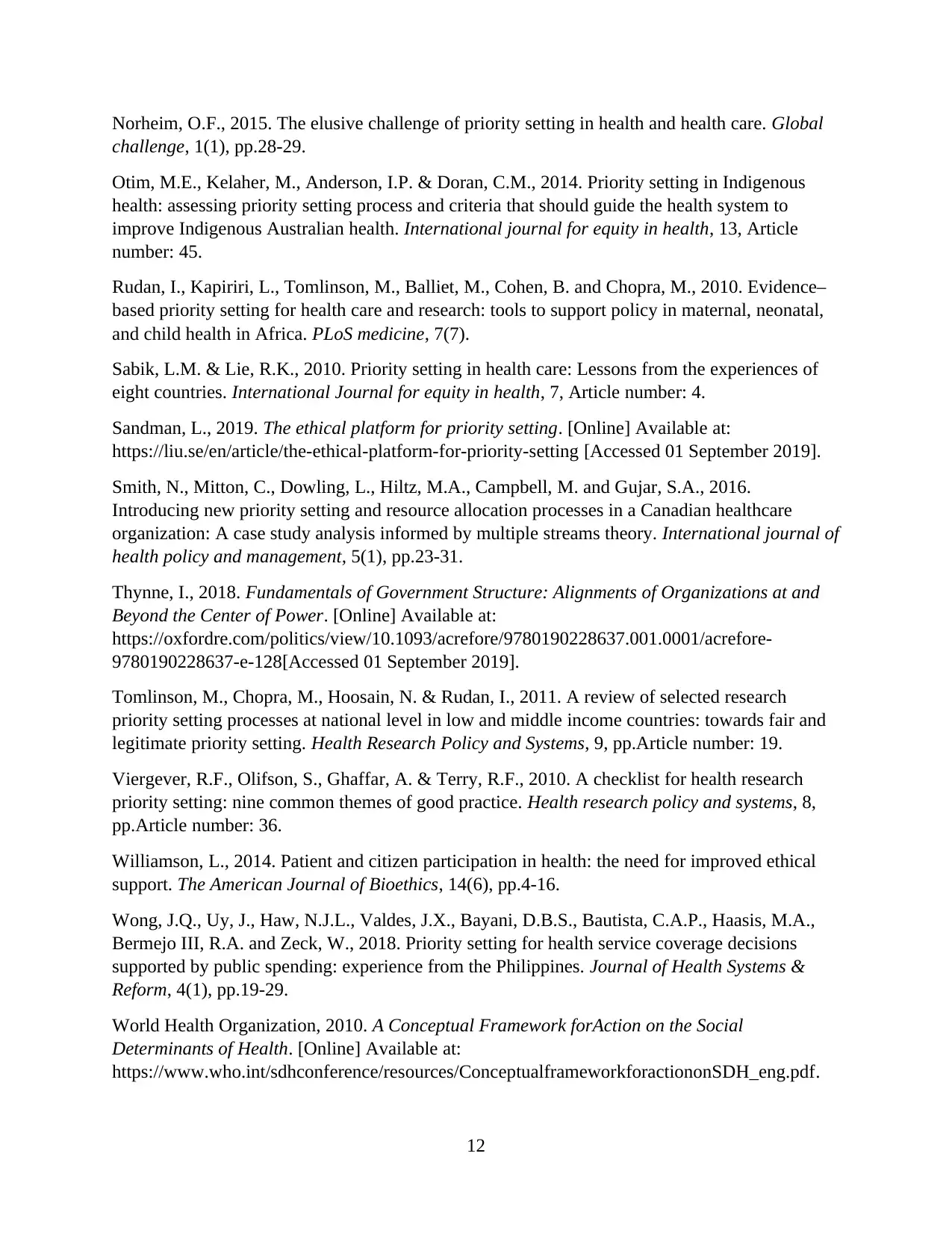
Norheim, O.F., 2015. The elusive challenge of priority setting in health and health care. Global
challenge, 1(1), pp.28-29.
Otim, M.E., Kelaher, M., Anderson, I.P. & Doran, C.M., 2014. Priority setting in Indigenous
health: assessing priority setting process and criteria that should guide the health system to
improve Indigenous Australian health. International journal for equity in health, 13, Article
number: 45.
Rudan, I., Kapiriri, L., Tomlinson, M., Balliet, M., Cohen, B. and Chopra, M., 2010. Evidence–
based priority setting for health care and research: tools to support policy in maternal, neonatal,
and child health in Africa. PLoS medicine, 7(7).
Sabik, L.M. & Lie, R.K., 2010. Priority setting in health care: Lessons from the experiences of
eight countries. International Journal for equity in health, 7, Article number: 4.
Sandman, L., 2019. The ethical platform for priority setting. [Online] Available at:
https://liu.se/en/article/the-ethical-platform-for-priority-setting [Accessed 01 September 2019].
Smith, N., Mitton, C., Dowling, L., Hiltz, M.A., Campbell, M. and Gujar, S.A., 2016.
Introducing new priority setting and resource allocation processes in a Canadian healthcare
organization: A case study analysis informed by multiple streams theory. International journal of
health policy and management, 5(1), pp.23-31.
Thynne, I., 2018. Fundamentals of Government Structure: Alignments of Organizations at and
Beyond the Center of Power. [Online] Available at:
https://oxfordre.com/politics/view/10.1093/acrefore/9780190228637.001.0001/acrefore-
9780190228637-e-128[Accessed 01 September 2019].
Tomlinson, M., Chopra, M., Hoosain, N. & Rudan, I., 2011. A review of selected research
priority setting processes at national level in low and middle income countries: towards fair and
legitimate priority setting. Health Research Policy and Systems, 9, pp.Article number: 19.
Viergever, R.F., Olifson, S., Ghaffar, A. & Terry, R.F., 2010. A checklist for health research
priority setting: nine common themes of good practice. Health research policy and systems, 8,
pp.Article number: 36.
Williamson, L., 2014. Patient and citizen participation in health: the need for improved ethical
support. The American Journal of Bioethics, 14(6), pp.4-16.
Wong, J.Q., Uy, J., Haw, N.J.L., Valdes, J.X., Bayani, D.B.S., Bautista, C.A.P., Haasis, M.A.,
Bermejo III, R.A. and Zeck, W., 2018. Priority setting for health service coverage decisions
supported by public spending: experience from the Philippines. Journal of Health Systems &
Reform, 4(1), pp.19-29.
World Health Organization, 2010. A Conceptual Framework forAction on the Social
Determinants of Health. [Online] Available at:
https://www.who.int/sdhconference/resources/ConceptualframeworkforactiononSDH_eng.pdf.
12
challenge, 1(1), pp.28-29.
Otim, M.E., Kelaher, M., Anderson, I.P. & Doran, C.M., 2014. Priority setting in Indigenous
health: assessing priority setting process and criteria that should guide the health system to
improve Indigenous Australian health. International journal for equity in health, 13, Article
number: 45.
Rudan, I., Kapiriri, L., Tomlinson, M., Balliet, M., Cohen, B. and Chopra, M., 2010. Evidence–
based priority setting for health care and research: tools to support policy in maternal, neonatal,
and child health in Africa. PLoS medicine, 7(7).
Sabik, L.M. & Lie, R.K., 2010. Priority setting in health care: Lessons from the experiences of
eight countries. International Journal for equity in health, 7, Article number: 4.
Sandman, L., 2019. The ethical platform for priority setting. [Online] Available at:
https://liu.se/en/article/the-ethical-platform-for-priority-setting [Accessed 01 September 2019].
Smith, N., Mitton, C., Dowling, L., Hiltz, M.A., Campbell, M. and Gujar, S.A., 2016.
Introducing new priority setting and resource allocation processes in a Canadian healthcare
organization: A case study analysis informed by multiple streams theory. International journal of
health policy and management, 5(1), pp.23-31.
Thynne, I., 2018. Fundamentals of Government Structure: Alignments of Organizations at and
Beyond the Center of Power. [Online] Available at:
https://oxfordre.com/politics/view/10.1093/acrefore/9780190228637.001.0001/acrefore-
9780190228637-e-128[Accessed 01 September 2019].
Tomlinson, M., Chopra, M., Hoosain, N. & Rudan, I., 2011. A review of selected research
priority setting processes at national level in low and middle income countries: towards fair and
legitimate priority setting. Health Research Policy and Systems, 9, pp.Article number: 19.
Viergever, R.F., Olifson, S., Ghaffar, A. & Terry, R.F., 2010. A checklist for health research
priority setting: nine common themes of good practice. Health research policy and systems, 8,
pp.Article number: 36.
Williamson, L., 2014. Patient and citizen participation in health: the need for improved ethical
support. The American Journal of Bioethics, 14(6), pp.4-16.
Wong, J.Q., Uy, J., Haw, N.J.L., Valdes, J.X., Bayani, D.B.S., Bautista, C.A.P., Haasis, M.A.,
Bermejo III, R.A. and Zeck, W., 2018. Priority setting for health service coverage decisions
supported by public spending: experience from the Philippines. Journal of Health Systems &
Reform, 4(1), pp.19-29.
World Health Organization, 2010. A Conceptual Framework forAction on the Social
Determinants of Health. [Online] Available at:
https://www.who.int/sdhconference/resources/ConceptualframeworkforactiononSDH_eng.pdf.
12
⊘ This is a preview!⊘
Do you want full access?
Subscribe today to unlock all pages.

Trusted by 1+ million students worldwide
1 out of 12
Related Documents
Your All-in-One AI-Powered Toolkit for Academic Success.
+13062052269
info@desklib.com
Available 24*7 on WhatsApp / Email
![[object Object]](/_next/static/media/star-bottom.7253800d.svg)
Unlock your academic potential
Copyright © 2020–2025 A2Z Services. All Rights Reserved. Developed and managed by ZUCOL.




